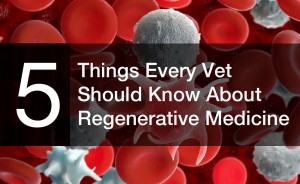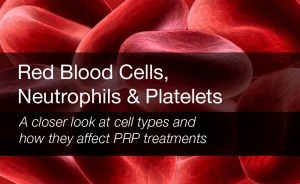5 Things Every Pet Owner Should Know About Regenerative Medicine
In our previous post, we discussed the five most important things every veterinarian should know about regenerative medicine. But as with any veterinary treatment, it is important to not only educate the veterinary professional performing the therapy, but also the pet owner whose companion may benefit from this therapy. With this in mind, here are 5 things every pet owner should know about regenerative medicine.
1. Regenerative Medicine uses the animal’s own cells to treat injured tissue
Regenerative medicine is a unique therapy that relies on the animal’s own cells to initiate healing and repair of injured tissue. Whether treating with Platelet Rich Plasma (PRP) or Bone Marrow Aspirate Concentrate (BMAC), the cells that are isolated using a special process have unique properties that accelerate healing, especially in areas that have poor blood flow. These areas can include cartilage, tendons and ligaments. Because the cells are treating the animal they were taken from, the likelihood of an adverse event from a treatment is minimal.
2. Regenerative Medicine can provide long lasting pain relief and healing
Therapeutic effects from PRP treatments for dogs with mild to moderate osteoarthritis have been reported to last up to 9 months, with select cases lasting for more than a year! Practitioners have even reported case outcomes enabling the withdrawal of NSAID and other joint medications completely. Treatments utilizing BMAC stem cells, with special regard to ligament and tendon treatments, have reported complete healing of the tissue from a single treatment and return to sport/ function within a short period of time. Although some PRP treatments may require more than one administration, it may be a convenient alternative to daily dosing of oral medications.
3. Treatments are fast and minimally invasive
Treating with PRP or BMAC stem cells is fast and can be done within a single veterinary visit. Platelet rich plasma only requires a sampling of blood, which is then processed using a specialized system, which takes less than 15 minutes. BMAC treatments take less than 30 minutes, in which the dog is placed under anesthesia and bone marrow is collected and processed similar to PRP. Once samples are ready, they are injected directly into the area they are needed and the patient can begin their recovery.
4. Thousands of animals (and people) have been treated using regenerative medicine
From top performing agility dogs to trusty companions, regenerative medicine has been used to treat thousands of dogs, horses and cats for a wide range of injuries for over 20 years. Its growing popularity has been in part due to famous (two legged) athletes receiving the treatments, including Tiger Woods and Kobe Bryant.
5. Regenerative Medicine is not a “cure-all”
As with any therapy, there is no “silver bullet”. It takes a multi-modal approach to truly see exceptional results, and regenerative medicine is no exception. Injecting PRP or BMAC stem cells is only one part of the “treatment puzzle”, which should also include a comprehensive rehabilitation therapy program including modalities such as laser therapy, underwater treadmill, therapeutic exercise and others.
It is also important to note that regenerative medicine does not cure or prevent arthritis. Although PRP and BMAC stem cells help with the healing and repair of the tissue, they cannot reverse arthritis or build cartilage that is no longer there. In many severe arthritis cases, regenerative medicine aids with the health of the joint and provides pain relief rather than rebuilding lost tissue.
For more information on regenerative medicine or to learn more about the Companion Regenerative Therapies System, please click here.
Stay tuned for our next blog where we will discuss intra articular injections and how they are used in veterinary medicine!
“5 Things Every Vet Should Know About Regenerative Medicine”
 In our previous posts, we’ve explored numerous topics surrounding regenerative medicine. But with all the literature and new data regarding these therapies, it’s easy to feel overwhelmed with information. That’s why we’ve decided to condense this material to provide you with the 5 most important things every veterinarian should know about regenerative medicine.
In our previous posts, we’ve explored numerous topics surrounding regenerative medicine. But with all the literature and new data regarding these therapies, it’s easy to feel overwhelmed with information. That’s why we’ve decided to condense this material to provide you with the 5 most important things every veterinarian should know about regenerative medicine.
1. Regenerative Medicine is not a new therapy
This may come as a surprise, but regenerative therapies including Platelet Rich Plasma (PRP) and Stem Cell therapy have been around for more than 20 years. Pioneered in the 1970’s, PRP and stem cell therapy has been widely used in dentistry, plastic surgery and orthopedic procedures, treating both athletes (Tiger Woods and Kobe Bryant to name a couple) and the “weekend warrior” alike. It has also been a common therapy in the equine world, treating many of the top race horses during and after their careers. This has provided us with 20 years’ worth of data and scientific backing to these therapies, many of which can be found on a publication search such as pubmed.gov.
2. Not all systems are validated for veterinary use
Because regenerative medicine has been around for several years, many of the systems that have been made available in the veterinary market came over from the human medical field. These systems which were originally engineered to process human samples, are now processing those samples from our canine patients. However, as we discussed in our previous post regarding validation, it is important to make sure whichever system is being used has been validated and optimized for the specific species it intends to treat. It is equally important that the validation has been performed by a 3rd party to eliminate bias in the final results. Click here to read the multicenter validation study for the CRT system.
3. Providing these therapies does not require a large time commitment
Processing for PRP or stem cell therapy can take less than 30 minutes and can be done in your own practice. No longer do you have to send out samples and wait for days or weeks to treat your patients. In less than 30 minutes you can collect, process and administer your PRP or stem cell treatments, making it a convenient therapy for both you and your clients alike.
4. Technicians can do the majority of the procedure
In addition to the minimal time required for processing samples, the majority of the work can be done by your hospital staff. Scheduling for these procedures requires a small time commitment of the administering vet, allowing your clinic to see more patients and utilizing your staff’s time efficiently.
5. You have support!
Venturing into regenerative medicine doesn’t have to be a solo journey! There are numerous educational courses, events, hands on trainings and webinars available year-round, which provide you support as you enter into this area of therapeutics. As with all Companion Animal Health products, education is our number one priority, which is why with each purchase of the CRT system, an 8-chapter training video is included along with a 1 hour live web training to for your supporting staff. Take a look at the Education & Training tab on our website, which contains both upcoming events and previously recorded webinars.
Stay tuned for our next blog post where we will look at the 5 things every pet owner should know about regenerative medicine.
“Red Blood Cells, Neutrophils and Platelets – A closer look at cell types and how they affect PRP treatments”
 Blood is arguably the most important life sustaining component of the body. For our companion animals, blood comprises on average 7% of the dog’s body weight and carries out several critical functions including transportation of oxygen and nutrients to the cells, removal of waste products and healing of damaged tissues. Each component of blood is responsible for a specific function to maintain homeostasis. Red Blood Cells (RBCs) transport oxygen and carbon dioxide between tissues and lungs. White Blood Cells (WBCs), including neutrophils, eosinophils, basophils, lymphocytes and monocytes, function as part of the body’s defense mechanism to fight off infections and disease. Platelets, as we have learned from our previous blogs, are important for their clotting abilities as well as their growth factors for tissue repair and healing. Last but not least, plasma, which is the fluid portion of blood, is responsible for transporting the above cell types along with delivering important proteins and other dissolved nutrients to various tissues of the body.
Blood is arguably the most important life sustaining component of the body. For our companion animals, blood comprises on average 7% of the dog’s body weight and carries out several critical functions including transportation of oxygen and nutrients to the cells, removal of waste products and healing of damaged tissues. Each component of blood is responsible for a specific function to maintain homeostasis. Red Blood Cells (RBCs) transport oxygen and carbon dioxide between tissues and lungs. White Blood Cells (WBCs), including neutrophils, eosinophils, basophils, lymphocytes and monocytes, function as part of the body’s defense mechanism to fight off infections and disease. Platelets, as we have learned from our previous blogs, are important for their clotting abilities as well as their growth factors for tissue repair and healing. Last but not least, plasma, which is the fluid portion of blood, is responsible for transporting the above cell types along with delivering important proteins and other dissolved nutrients to various tissues of the body.
Although each cell type has a specific and beneficial function in the circulating blood, their inclusion in the PRP sample can be detrimental to the tissue it is being used to treat. RBCs make up approximately 45% of the blood’s volume. Although they are important for the exchange of gas substances in tissues when circulating, they can also be damaging to cartilage and synovium. When RBC’s are exposed directly to any tissue without the barrier provided by a vessel, they produce harmful Reactive Oxygen Species and also increase the concentration of unwanted inflammatory mediators including IL-1 and TGF-α. Injection of RBC’s directly into a tissue would result in further tissue damage and could lead to increased pain for the patient. In short, we want to effectively exclude RBCs from our PRP sample to reduce the possibility of damaging the tissue and negating the positive effects of the PRP.
Neutrophils, which are the most abundant WBC, are the first line of defense against invading microorganisms. Typically observed in the early stages of infection, neutrophils have the ability to kill microorganisms immediately and non-specifically, without having a “learned” immune response. Although this is beneficial for the control of infections, neutrophils are detrimental to cartilage and synovium as observed in autoimmune diseases including Rheumatoid Arthritis and common tick-borne diseases including Lyme Disease. Neutrophils increase the concentrations of unwanted inflammatory mediators which include IL-1β, TNF-α, IL-6 and IL-8. It has also been observed that neutrophils, when included in a PRP sample, correlate with an increased concentration of MMP-9 which degrades collagen and other extracellular material. We can reason with this knowledge that neutrophils should also not be included in our final PRP sample due to their harmful effects on the tissue.
So what about the other White Blood Cell types? The jury is still out on whether there is an ideal concentration for monocytes, lymphocytes and the other cell types. Their elimination or inclusion is still under investigation and as regenerative medicine continues to evolve, our knowledge and understanding of what the “perfect” PRP sample will become clearer. What we do understand from our current knowledge of these cells and how they function is that in an ideal PRP sample, we want a higher concentration of platelets for their beneficial growth factors and we want a reduced number of RBC’s and neutrophils. For more information about the Companion Regenerative Therapies (CRT) System or to learn more about PRP therapy, please click here.
Stay tuned for our next blog where we look at the 5 most important things every vet should know about regenerative medicine!




